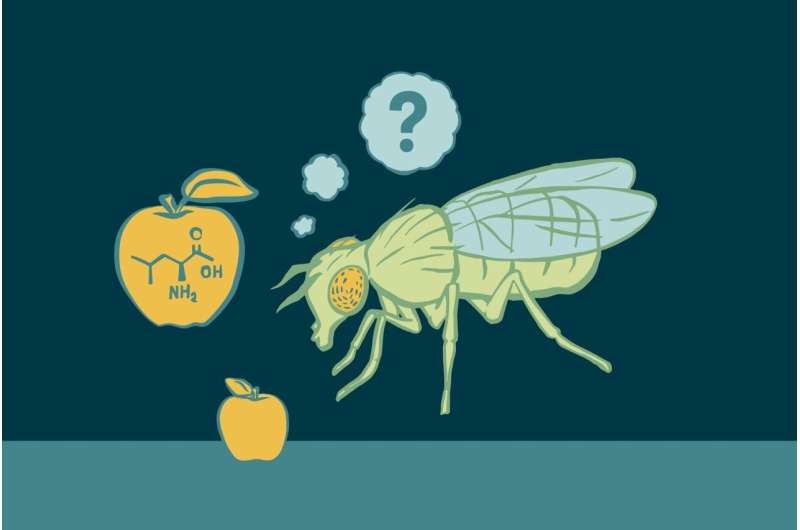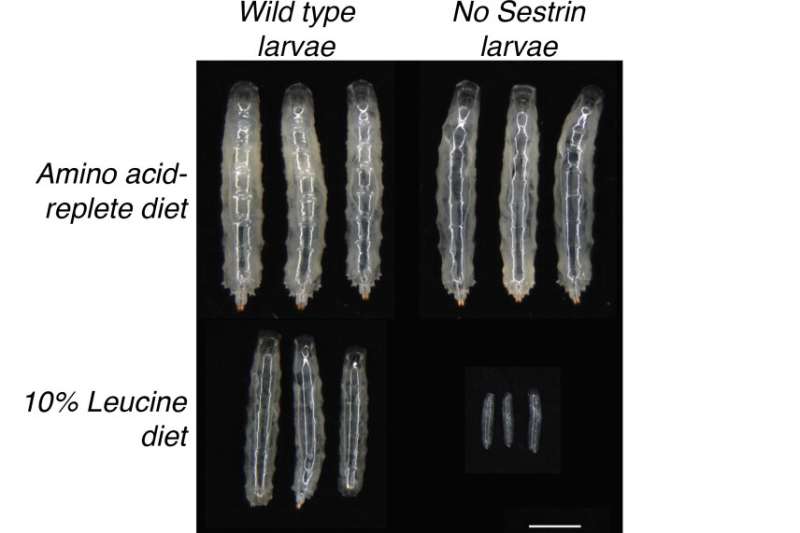Metabolic protein explains how flies choose 'healthy' food

Many animals, including humans, have a preference for nutrient-balanced diets. Among all essential nutrients, multicellular organisms need to consume the building blocks of proteins, called amino acids, in order to build proteins of their own. Humans might decide on the best foods for them by reading nutrition labels, but it's less clear how other animals inherently "know" which foods they need to function.
"Our overarching question is, 'How do animals sense the nutrient availability in their food to regulate their own growth?'" said Xin Gu, a former graduate student at Whitehead Institute.
A new paper, published July 20 in Nature and led by Gu and coauthor Patrick Jouandin, a postdoctoral researcher at Harvard in the lab of fly genetics expert and Harvard professor Norbert Perrimon, shows that a family of proteins called Sestrins allows flies to sense the presence of the essential amino acid leucine—and choose foods with higher amounts of the nutrient. The protein also interacts with metabolic pathways to help the flies find ways of coping when leucine is in short supply.
Over the past few years, Whitehead Institute researchers have studied the role of Sestrin proteins in cultured cells as well as in mice, focusing on how these proteins interact with the important growth regulator mTOR1 to convey the presence or absence of leucine. The researchers decided to study the system in the fruit fly Drosophila melanogaster because flies only have one Sestrin protein while mammals have three, making for cleaner experiments on the specific role of this family. Flies also have shorter lifespans and more progeny, making it easier to glean large-scale experimental results.
As in mice, fly Sestrin binds to leucine. When leucine levels drop, Sestrin binds the protein complex GATOR2, effectively turning off the mTOR pathway and slowing metabolism. The researchers reasoned that Sestrin's ability to suppress mTORC1 when faced with a dearth of leucine had evolved to help the animals adapt to diets lacking the nutrient, likely because flies that could sense leucine could shut off the mTOR pathway and activate autophagy, a sort of cellular recycling process. This would allow them to conserve nutrients and survive longer.
Gu and Jouandin began their inquiry by creating fly larvae with the gene for Sestrin mutated so the protein could not be made in the flies' cells. They then fed these mutant flies, alongside normal flies, a leucine-free diet. The researchers hit a small setback when it turned out that every larva, regardless of genotype, died within two to three days. But that made sense, since leucine is an essential nutrient for larval growth.
The researchers tried again with food that contained about 1/10 the normal amount of leucine, and this time found that normal larvae were four times more likely to survive on this diet than Sestrin knockouts; when normal larvae were deprived of leucine, about 40 percent of them survived to adulthood. When the Sestrin-mutant flies were fed a leucine-free diet, they fared much worse—only 10 percent survived.

The researchers next wanted to test whether the presence of Sestrin proteins helped flies make a choice about what foods they would rather eat. The researchers set up a fly buffet, where they offered flies a choice of apples that had been brushed with a leucine solution or apples that had been brushed with water. Over around six hours, normal flies developed a preference for the leucine apples. Flies lacking Sestrin couldn't tell the difference.
Because it took the flies a long time to develop this preference, the researchers reasoned the mechanism must be more complex than just taste. (Plus, leucine might not even taste that good anyway. "It's actually quite interesting because leucine itself, if you ever taste it, it's quite bitter," Gu said. "It's not one of the yummiest amino acids, at least for humans.")
The extra time it took for the flies to start making their choice suggested that the flies were experiencing a different type of desire for leucine. "I would imagine that it's a very similar feeling to a craving, like this internal hunger," Gu said. "Your organs, your gut and maybe some other cells in your body are telling you, 'We haven't had this type of nutrient for a while.'"
The researchers also knew that flies' diet can have an effect on their ovaries and how many eggs they produce, and decided to investigate the contribution of Sestrin to this part of the flies' life cycles. Flies lacking a working Sestrin gene—and therefore the ability to sense leucine and a constitutively lower mTORC1 activity—produced fewer eggs than normal flies. Furthermore, flies that were able to sense leucine preferred to lay eggs on food that contained the nutrient, while the leucine-oblivious flies had reduced preference.
Gu and Jouandin then took the question a step further, to see if there were specific cell types that were especially important in the leucine-sensing process. They found that lowering levels of Sestrin in glial cells—the cells in the body that convey information and nutrients to the neurons in the brain—was sufficient to reduce flies' preference for leucine-spiked apples. "One thing we want to figure out is how the glial cells impact the downstream neurons, which are responsible for making the distinction between two types of diet," she said.
These studies only looked at the flies' own genetics, but Gu and Jouandin are also interested in how nutrient-sensing systems are integrated all together as an exciting future direction is to identify other types of nutrients—like leucine—that have this sort of direct impact on food choices. "If there are other nutrients [that affect decision-making this way] we want to know what are the sensors for those, and how do those sensors impact animal behavior together with Sestrin?" Gu said.
"Metabolism as a field is really complicated because one single nutrient can have potentially hundreds of different roles," said Jouandin. "It takes tedious and careful approaches to be able to really demonstrate that one particular nutrient is going to be useful to do this one thing—and that's just for one organism. So that's why it's important to study all those nutrients one by one."
More information: Xin Gu et al, Sestrin mediates detection of and adaptation to low-leucine diets in Drosophila, Nature (2022). DOI: 10.1038/s41586-022-04960-2
Journal information: Nature
Provided by Whitehead Institute for Biomedical Research




















